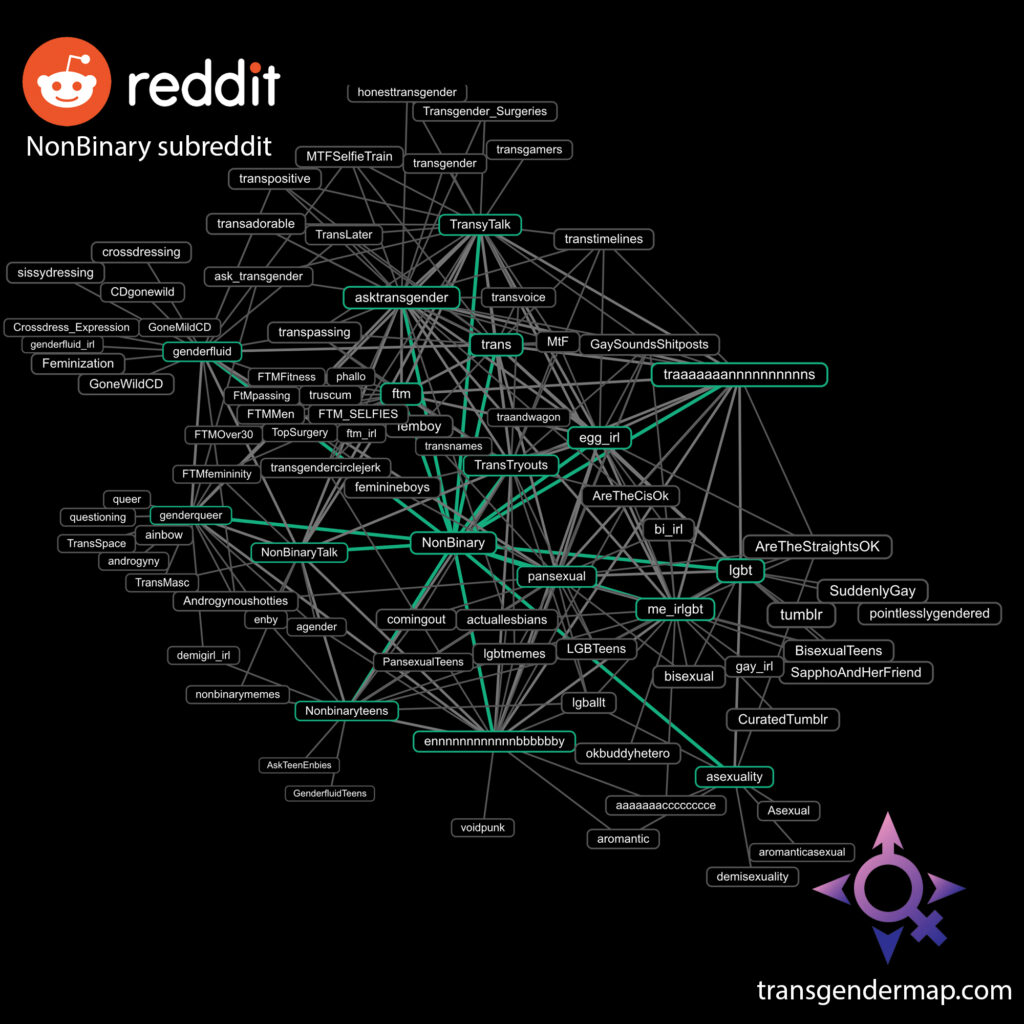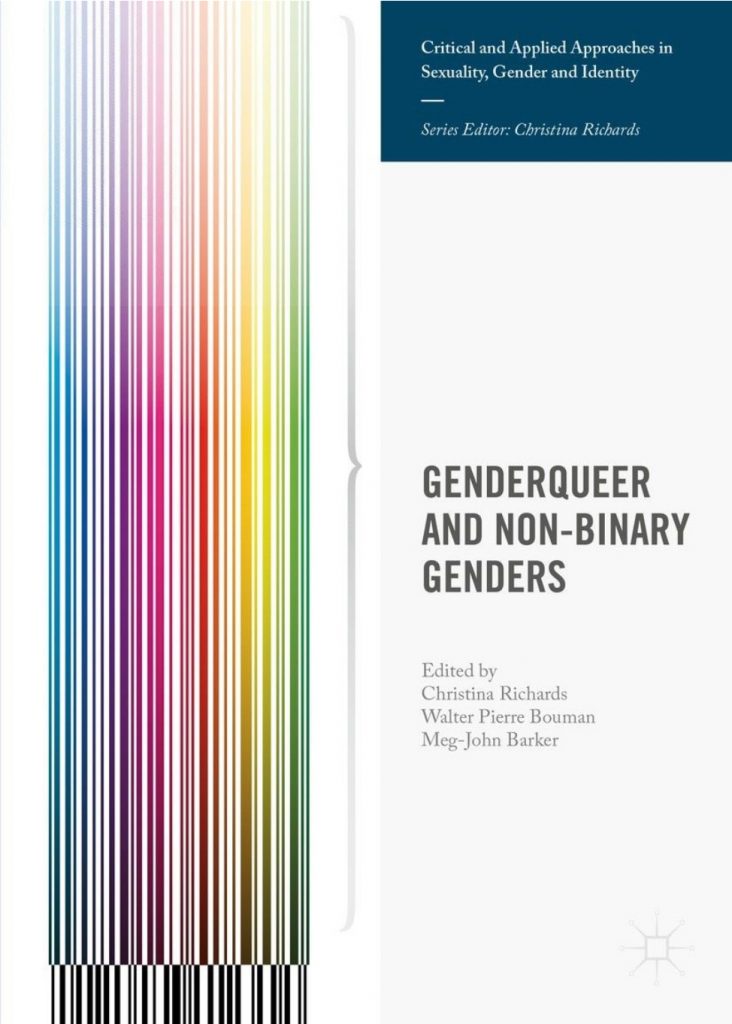Nonbinary (or non-binary) people identify and/or express gender in ways that do not conform to a gender binary. They sometimes use the abbreviations enby or NB. The term is closely related to genderqueer and genderfluid. Some nonbinary people seek social, medical, and/or legal gender transition options.
Background
The concept of “non-binary” emerged from deconstructionism, a school of thought which seeks to break down social constructs, many of which operate under what philosopher Ferdinand de Saussure calls binary opposition. As an example, the long-held idea of “opposite sexes” creates the category of “sex” as one of two mutually exclusive opposing terms: male or female. In this school of thought, binary opposition created a hierarchy where one of the two components is dominant. Challenging binary oppositions is an important part of postmodernism, an intellectual movement that uses rhetorical, critical, and strategic means to destabilize concepts and beliefs that some people consider stable or even unchangeable.
In politics and activism, this strategy can be seen in conceptual framings like queer theory, third-wave feminism, post-colonialism, critical race theory, and gender theory. These framings interact with each other in what Kimberlé Crenshaw describes as intersectionality. These schools of thought argue that socially constructed binaries legitimize and perpetuate power structures favoring a specific group.
History
The term nonbinary as a gender identity emerged in the late 20th century. Controversial sexologist John Money was an important early figure in theories about socially constructed gender identity and gender role. Subsequent ideas about gender were heavily influenced by the work of Judith Butler, whose 1990 book Gender Trouble is a foundational text of queer theory and an early exploration of the gender binary. In 1990, Barrie Thorne discussed the “construction of gender as binary opposition.”
Thinkers and cultural critics increasingly began to challenge binary opposition inherent in constructs like man/woman, heterosexual/homosexual, masculine/feminine, cisgender/transgender, and so on. People who felt they were better described outside of those constructs began putting those theories to practice, adopting new identities and expressions. Notable examples include Kate Bornstein‘s 1994 book Gender Outlaw and Riki Ann Wilchins’ activist group Transexual Menace in the mid-1990s. Wilchins’ Gender Public Advocacy Coalition (GenderPAC) organized the first National Gender Lobbying Day in October 1995. Their publications like In Your Face and their anthology GenderQueer: Voices From Beyond the Sexual Binary began using new terms like genderqueer.
I first encountered the term non-binary in the mid-1990s online on AOL and USENET’s soc.support.transgendered, though it likely appeared online before then. Via the Oxford English Dictionary:
The adjective non-binary with the specific meaning of ‘Designating a person who does not acknowledge or fit the conventional notions of male and female gender, and instead identifies as being of another or no gender, or a combination of genders; (also) of or relating to such a person’, dates from 1995 and was added to the OED in 2018.
I believe the first published instance of “non-binary gender constructions” was by Gill Branston in 1995. In the sense of sexual embodiments, British author Ashley Tauchert used the phrase “non-binary gender” in the 2001 essay “Beyond the binary: fuzzy gender and the radical center.” American theologian and activist Justin Sabia-Tanis used the term “nonbinary people” in his 2003 book. Nonbinary as an identity was later popularized in queer online spaces like tumblr and Autostraddle. Many notable people now identify as nonbinary, including politicians, athletes, activists, artists, and scientists.
Nonbinary reddit communities
Following the decline of tumblr and standalone forums, reddit has become a community hub for enbies. The community clusters in several overlapping interests.
Nonbinary+
Transgender+
Sexuality+

Books

Genderqueer and Non-Binary Genders
- Great overview.
Resources
Genderqueer and Non-Binary Identities (genderqueerid.com)
- Maintained by Marilyn Roxie. The best nonbinary resource online.
Transgender Law Center (transgenderlawcenter.org)
- Published Beyond the Binary (PDF)
Gender Wiki (gender.wikia.org)
- Collaborative gender-based reference work.
genderqueer (genderqueer.tumblr.com)
Neutrois (neutrois.com)
Genderfork (genderfork.com)
Exobinary (exobinary.info)
- Maintained by Cory Dostie. Includes a section on vocab links.
Agender.info (agender.info)
Genderqueer.me (genderqueer.me)
References and notes
Butler, Judith (1990). Gender Trouble: Feminism and the Subversion of Identity. ISBN 0-415-38955-0
Thorne, Barrie. (1990). “Children and Gender: Constructions of Difference.” In Theoretical Perspectives on Sexual Difference. Edited by Deborah L. Rhode.
we can specify not only the social relations that uphold but also those that undermine the construction of gender as binary opposition.
Barrie, 108
Bornstein, Kate (1994). Gender Outlaw. Routledge, ISBN 9780415908979
The continued oppression of women proves only that in any binary there’s going to be one up and one down. The struggle for equal rights must include the struggle to dismantle the binary.
[…]
We’re moving from perverts to experts in that venue, those of us who are speaking out, telling our stories. The next step will be when these shows take on a panel of us non-gendered folks talking about the nature of identity in this culture.
Roberts, N. Leila (January 13, 1995). questions to all. soc.support.transgendered via Google Groups https://groups.google.com/g/soc.support.transgendered/c/t3Rw13oSxe0/m/eqqawubHJAEJ
At what point does a transsexual identity become a man or woman identification, depending on the gender of your choice? Do you ever really feel as if you’ve moved from that non-binary existence as a transsexual into a real man or woman? (Don’t mistake me, here… as far as I’m concerned, a ‘real’ man or woman is whoever wants to be one.)
Branston, Gill (1995). Viewer, I listened to him … voices, masculinity, In the line of fire. In Janet Thumin, Pat Kirkham, eds. Me Jane: Masculinity, Movies, and Women. ISBN 9780312127671
Nor, given my interest in non-binary gender constructions and personal relationships which fuse the loving, the companionate / comradely, the sexual and the sublime…
Conaty, Tracy (August 15, 1995). “Another one. It just doesn’t stop: Tyra Hunter. In Your Face https://www.digitaltransgenderarchive.net/files/9019s249g
Every once in awhile a story hits and you remember how dangerous it is being a genderqueer in this society, even with regard to the most elemental human functions, like helping the sick and injured.
Staff report (2 Oct 1995). Washington Times, p. a8. [National Gender Lobbying Day coverage] Picked up in LGBT publications like the Wisconsin Light (Transgender Activists Lobby Congress, 12-25 October 1995, p. 2).
It’s high time ‘Genderqueers’ came out of the closets, out of the shadows and out of the margins. Too many of us have lost our jobs, our homes, and even our lives simply because of who and what we are. We work. We vote. We pay taxes. And we will no longer be silenced or shamed into political immobility. With Lobbying Day, we announce to the world that we are out for good.
Quoting organizer Riki Anne Wilchins (1995)
Wilchins, Riki Anne (Spring 1995) A Note from Your Editrix. In Your Face, #1 (Spring 1995), p. 4. https://www.digitaltransgenderarchive.net/files/1831ck00f?fbclid=IwAR2ah-yZb92tmAoxDs0TNItcs37U67OU6RQ7ojqOrjz2ErQdkWRVITXLvVM
The fight against gender oppression has been joined for centuries, perhaps millennia. What’s new today, is that it’s moving into the arena of open political activism. And nope, this is not just one more civil rights struggle for one more narrowly defined minority. It’s about all of us who are genderqueer: diesel dykes and stone butches, leather queens and radical fairies, nelly fags, crossdressers, intersexed, transexuals, transvestites, transgendered, transgressively gendered, intersexed, and those of us whose gender expressions are so complex they haven’t even been named yet. More than that, it’s about the gender oppression which affects everyone: the college sweetheart who develops life-threatening anorexia nervosa trying to look “feminine,” the Joe Sixpack dead at 45 from cirrhosis of the liver because “real men” are hard drinkers. But maybe we genderqueers feel it most keenly, because it hits us each time we walk out the front door openly and proudly. And that’s why these pages are only going to grow. We’re not invisible anymore. We’re not well behaved. And we’re not going away. Political activism is here to stay. So get out. Get active. Picket someone’s transphobic ass. Get in someone’s genderphobic face. And while you’re at it, pass the word: the gendeRevolution has begun, and we’re going to win.
Wichins (1995)
Tauchert, Ashley (2001). Beyond the binary: fuzzy gender and the radical center. In Erica McWilliam, Felicity Haynes, Tarquam McKenna, eds. Unseen Genders: Beyond the Binaries. Peter Lang, ISBN 9780820450247
[…] embodied subjects materialize in a whole range of sexual embodiments — from 100 % male-embodied to 100 % female-embodied — we can apply our model of the radical center to a non-binary gender and see what happens.
p. 189
Judith Roof (2002). Is There Sex after Gender? Ungendering/”The Unnameable” The Journal of the Midwest Modern Language Association Vol. 35, No. 1 (Spring, 2002), pp. 50-67. https://doi.org/10.2307/1315318
All acknowledge in one way or another the complicities of the sex/gender system, but though all suggest some notion of mobile, non-essential or even non-binary gender…
p. 43
Livia, Anna; Hall, Kira (1997). Queerly Phrased: Language, Gender, and Sexuality. Oxford University Press, ISBN 9780195104707
Holmes, Janet; Meyerhoff, Miriam; [Eds.] (2003). The Handbook of Language and Gender [First Edition]. Blackwell ISBN 9780631225027
Tanis, Justin Edward (2003). Trans-gendered: Theology, Ministry, and Communities of Faith. Pilgrim Press, ISBN 9780829815283
“This observation has important implications for trans people and our ability to accept ourselves as nonbinary people.”
Ehrlich, Susan; Holmes, Janet; Meyerhoff, Miriam [Eds.] (2014). The Handbook of Language, Gender, and Sexuality, Second Edition. Wiley Blackwell ISBN 9781118584330
Recently, feminist linguistic scholarship has likewise begun to examine how categories of gender, sex, and sexuality are put to work in more-than-binary identities in the late modern West.
Jeffner Allen, Ed. (1990) Lesbian Philosophies and Cultures State University of New York Press ISBN 9780791403846
Bonnie McElhinny Theorizing Gender in Sociolinguistics and Linguistic Anthropology. In The Handbook of Language and Gender
Sociologist Barrie Thorne found that she was drawn to the moments when gender divisions were highlighted. These gender-marked moments seemed, she wrote, “to express core truths: that boys and girls are separate and fundamentally different as individuals and as groups. They help[ed] sustain a sense of dualism in the face of enormous variation and complex circumstances” (1990:107). But the “truth,” she argues, turned out to be much more complex: we need, she maintains, to understand when gender is largely irrelevant, and when it seems central, when gender is marked and when it is unmarked, for it is only in “developing a sense of the whole and attending to the waning as well as the waxing of gender salience [that] we can specify not only the social relations that uphold but also those that undermine the construction of gender as binary opposition” (1990: 108).
Pat Kirkham The Gendered Object1996 9780719044755 ” The idea of volcano and vampire smells is certainly intriguing , but it is difficult to draw much hope for non – binary gender roles from these lines . “
Leslie Feinberg (1996). Transgender Warriors.
Lori B. Girshick (2008). Transgender Voices: Beyond Women and Men. University Press of New England, ISBN 9781584656838
“Stephe (androgyne male) pointed out the consequence of minimal understanding of nonbinary identities”